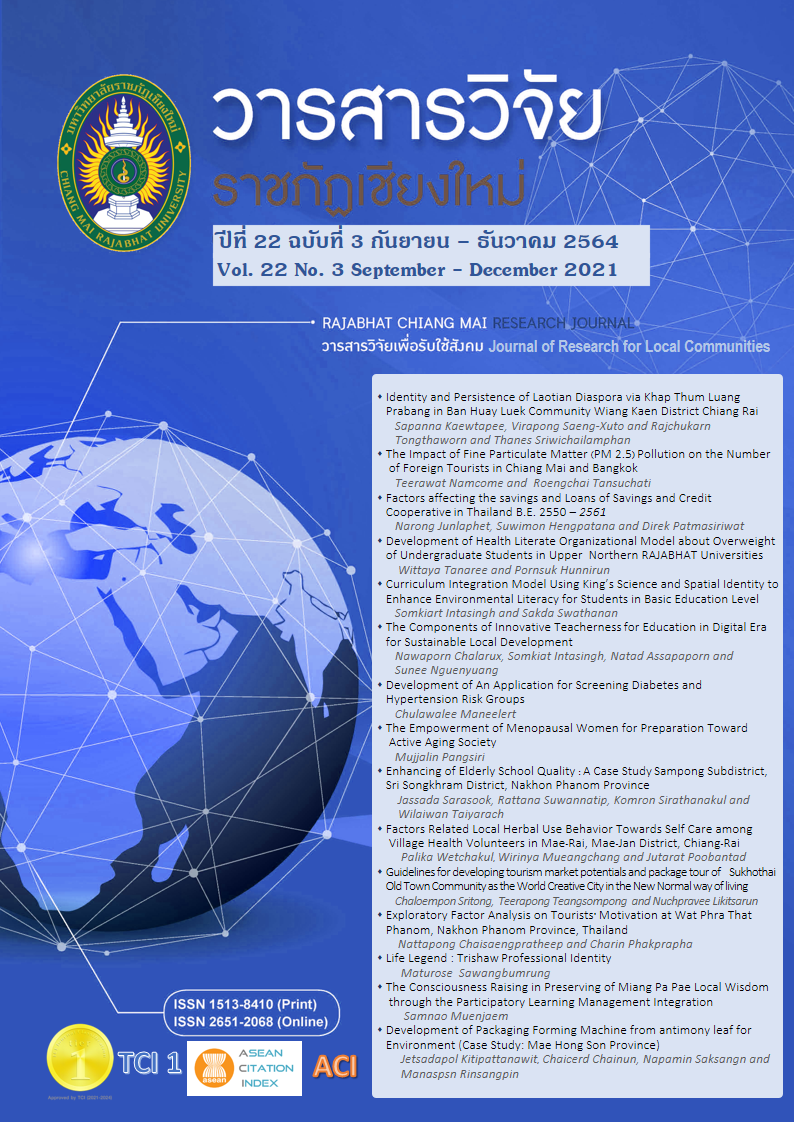Exploratory Factor Analysis on Tourists’ Motivation at Wat Phra That Phanom, Nakhon Phanom Province, Thailand
DOI:
https://doi.org/10.14456/rcmrj.2021.248030Keywords:
Exploratory Factor Analysis, Wat Phra That Phanom, Motivation, TouristAbstract
The purpose of this study was to conduct an exploratory factor analysis of the motivations of tourists who visit Wat Phra That Phanom. Utilizing the Khazanie formula (1996) and collecting accidental sampling, 384 tourists were surveyed using questionnaires. As part of the qualitative research, two village headmen, one layman and five vendors participated in structured interviews. As a result, the Index of item objective congruence (IOC) value was 0.79 and the value for Cronbach’s Alpha for the survey was α = 0.96. Furthermore, descriptive statistics were used to analyze the data such as the number, percentage, mean and standard deviation. It was determined that the exploratory factor analysis (EFA) would be analyzed by Principal Component Analysis and rotated by Varimax. The outcomes demonstrated that 1) Most of the tourists were female, 20-39 years old, marital status and a bachelor's degree. Being a company employee, earning 15,000-30,000 baht. 2) Most of them travelled to worship the relics by private cars; the cost was 1,501-3,000 baht. Most of them travelled on Saturday - Sunday. 3) Tourists were most motivated by status and reputation. And 4) Sixty-five percent of the variance was due to four main motivations and seventeen sub-components; the physical, religious, and reputation components accounted for 45.20% of the variance, which influenced most on the motivation of tourists visiting the temple; and second component is 19.99%. It was found that the majority of informants after be interviewed were in agreement on the motivating factor for tourists to visit the temple, and that the community could benefit both economically, socially, and generating income in the community as well as using the knowledge gained to develop the destination for the sustainability in the future
Downloads
References
Cohen, E. (2006). Religious tourism as an educational experience. London: Routledge.
Collins-Kreiner, N. (2010). The Geography of Pilgrimage and Tourism: Transformations and Implications for Applied Geography. Applied Geography, 30(1), 153–64. DOI: https://doi.org/10.1016/j.apgeog.2009.02.001
Digance, J. (2003). Pilgrimage at contested sites. Annals of Tourism Research, 30(1), 143-159. DOI: https://doi.org/10.1016/S0160-7383(02)00028-2
Horner, S., & Swarbrooke, J. (2007). Consumer Behavior in Tourism. Oxford: Elsevier.
Hsu, T. K., Tsai, Y. -F., & Wu, H. H. (2009). The preference analysis for tourist choice of destination: A case study of Taiwan. Tourism Management, 30(2), 288-297. DOI: https://doi.org/10.1016/j.tourman.2008.07.011
Kavoura, A. (2013). Politics of Heritage Promotion: Branding the Identity of the Greek State. Tourism. Culture and Communication, 12(2), 69-83. DOI: https://doi.org/10.3727/109830413X13575858951086
Keereephet, S., Thumathiwat, D.P., & Mankeb, P. (2018). Thai Tourists’ Satisfaction towards Ecotourism Management of Kiriwong Community, Lan Ska District, Nakhon Si Thammarat Province. King Mongkut’s Agicultural Journal, 36(1), 87-98. https://li01.tci-thaijo.org/index.php/agritechjournal/article/view/133023 (In Thai)
Khazanie, R. (1996). Statistics in a World of Applications. New York : HarperCollins College Publisher.
Kline, R.B. (2016). Principles and Practice of Structural Equation Modeling. New York: Guilford Press.
Kotchare, T. (2012). Thai Tourist’s Behavior in Birthday’s Relic of The Buddha Religious Tourism Nakorn Phanom Province. (Master of Business Administration Program in Tourism Management, Graduate School Khon Kaen University). (In Thai)
Kraiwan, Y. (2014). Analysis of multivariate statistics for research. Bangkok: Chulalongkorn Printing. (In Thai)
Luekveerawattana, R. (2019). The Study of Comparing Satisfaction of Visitors at Ecotourism Site, Koh Kret, Nonthaburi]. Journal of Multidisciplinary Academic Research and Development, 1(2), 42-52. https://he02.tci-thaijo.org/index.php/JMARD/article/view/173798 (In Thai)
Mu, Z., Li, H., Jian-Hong, W., Ji, L., Yan-Geng, J., & Xiting L. (2007). Religious tourism and cultural pilgrimage: A Chinese perspective. In: R. Raj and N.D. Morpeth (Eds). Religious Tourism and Pilgrimage Management, an International Perspective. Wallingford: CAB International.
Paris, C., & Teye, V. (2010). Backpacker Motivations: A Travel Career Approach. Journal of Hospitality Marketing & Management, 19(3), 244-259. DOI: https://doi.org/10.1080/19368621003591350
Pereira, G. D. A., & Gosling, M. (2019). Push and pull motivations of Brazilian travel lovers. BBR. Brazilian Business Review, 16(1), 63-86. DOI: https://doi.org/10.15728/bbr.2019.16.1.5
Queen Sirikit Commemorative National Library, Nakhon Phanom. (2017). Nakhon Phanom. Retrieved 6 February, 2020, Retrieve from http://www.finearts.go.th/parameters. (In Thai)
Sainaratchai, K., & Kieanwatana, K. (2019). The Development of Tourist’s Motivation towards Tourism in Sa Kaeo as Frontier Tourism Destination. Journal of Cultural Approach, 20(38), 81-90. https://so02.tci-thaijo.org/index.php/cultural_approach/article/view/209561 (In Thai)
Thanavongs, S. J. (2018). Buddhist Tourism: The Pattern and Network Tourism Management of the Temples in Thai Society. (Doctor of Philosophy, Social Development, Graduate School Mahachulalongkornrajavidyalaya University). (In Thai)
Timonthy, D., & Olsen, D. (2007). Tourism, Religion and Spiritual Journeys. Routledge: London.
Yue, T., Zhang, S., & Xu, Y. (2019). The Motivations of Chinese Tourists Visiting Abisko. Uppsala University.
Zhang, X., Prybutok, V.R. & Huang, A. (2006). An empirical study of factors affecting e-service satisfaction. Human Systems Management, 25(4), 279-291. DOI: 10.3233/HSM-2006-25406
Downloads
Published
How to Cite
Issue
Section
License
1. Articles, information, content, images, etc published in the “Community and Social Development Journal” are copyrighted by the Community and Social Development Journal, Chiang Mai Rajabhat University. In order to properly distribute the articles through print and electronic media, the authors still hold the copyright for the published articles under the Creative Commons Attribution (CC BY) license, which allows the re-distribution of the articles in other sources. References must be made to the articles in the journal. The authors are responsible for requesting permission to reproduce copyrighted content from other sources.
2. The content of the articles appearing in the journal is the direct responsibility of the article authors. The editorial board of the journal does not necessarily agree with or share any responsibility.














